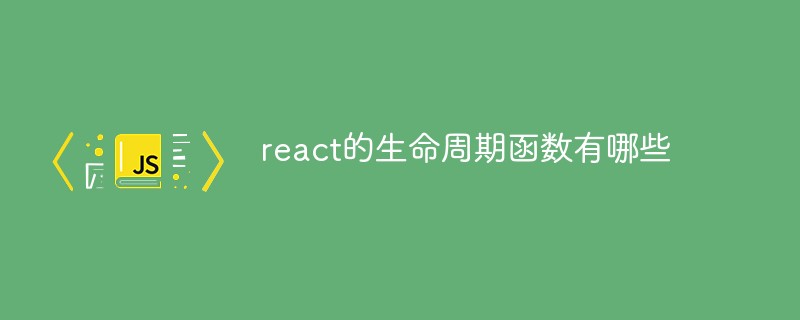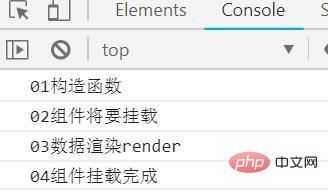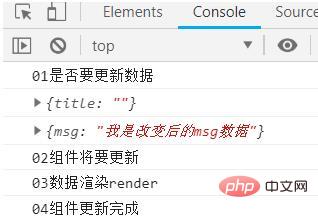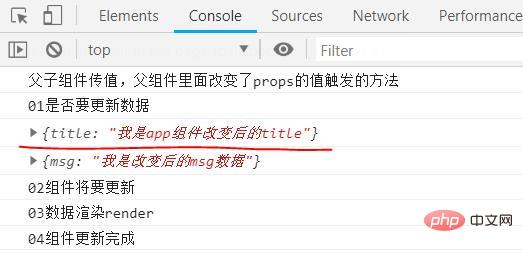What are the life cycle functions of react?
The life cycle functions of react are: 1. componentWillMount function; 2. componentDidMount function; 3. shouldComponentUpdate function; 4. componentWillUpdate function; 5. componentDidUpdate function; 6. componentWillUnmount function; 7. componentWillReceiveProps function.

The operating environment of this tutorial: Windows 10 system, react18.0.0 version, Dell G3 computer.
What are the life cycle functions of react?
react’s life cycle function (super detailed)
Without further ado, let’s get straight to the point!
First let’s take a look at the life cycle functions of react:
The function that is triggered when the component is about to be mounted: componentWillMount
The function that is triggered when the component is mounted: componentDidMount
The function that is triggered when the data is to be updated: shouldComponentUpdate
#The function that is triggered when the data is about to be updated: componentWillUpdate
The function that is triggered when the data update is completed Function: componentDidUpdate
Function triggered when the component is about to be destroyed: componentWillUnmount
Parent component The function that is triggered when props transfer values has been changed: componentWillReceiveProps
Let’s explain the code in detail
1. Mounting part
According to the official life cycle diagram, we can see that the loading and rendering of a component starts with defaultProps and propsTypes (these two will be discussed separately in the next article, and it is not the focus here)
Then there is constructor and the initial data in this.state, so here is the first step. Then the componentWillMount component is about to start mounting. This is the second step. Then the component is mounted, render parses and renders, so the third step is about to happen, that is, render data is all rendered, and finally componentDidMount
the component is mounted.
Sub-component code, just introduce rendering into the parent component (no code here)
import React ,{Component} from 'react'
class Smzq extends Component{
constructor(props){
console.log('01构造函数')
super(props)
this.state={
}
}
//组件将要挂载时候触发的生命周期函数
componentWillMount(){
console.log('02组件将要挂载')
}
//组件挂载完成时候触发的生命周期函数
componentDidMount(){
console.log('04组件将要挂载')
}
render(){
console.log('03数据渲染render')
return(
<div>
生命周期函数演示
</div>
)
}
}
export default SmzqOpen the console to view
2. Data update part
The first step for data update is shouldComponentUpdate to confirm whether to update the data, only when this function returns true Will be updated, and this function can declare two parameters nextProps and nextState,
nextProps is the value passed from the parent component to the child component, nextState is after the data is updated value, these two values can be obtained in this function. In the second step, after confirming the updated data, componentWillUpdate will update the data . The third step is still render. If the data changes, render will be re-rendered. The fourth step is componentDidUpdate data update is completed.
In terms of code, based on the previous part, the subcomponent defines an initial data in this.state, binds this data in render, and then adds a button to declare an onClick event to change this data. In this way, you can see the effect of the data update part. I have deleted the first part of the code here to make it look less messy.
import React ,{Component} from 'react'
class Smzq extends Component{
constructor(props){
super(props)
this.state={
msg:'我是一个msg数据'
}
}
//是否要更新数据,如果返回true才会更新数据
shouldComponentUpdate(nextProps,nextState){
console.log('01是否要更新数据')
console.log(nextProps) //父组件传给子组件的值,这里没有会显示空
console.log(nextState) //数据更新后的值
return true; //返回true,确认更新
}
//将要更新数据的时候触发的
componentWillUpdate(){
console.log('02组件将要更新')
}
//更新数据时候触发的生命周期函数
componentDidUpdate(){
console.log('04组件更新完成')
}
//更新数据
setMsg(){
this.setState({
msg:'我是改变后的msg数据'
})
}
render(){
console.log('03数据渲染render')
return(
<div>
{this.state.msg}
<br>
<hr>
<button>this.setMsg()}>更新msg的数据</button>
</div>
)
}
}
export default Smzq
3. Let’s talk about componentWillReceiveProps separately. The function that is triggered when the props value is changed in the parent component
This function is when we The function that is triggered when the parent component changes the value of props when passing values to the child component. As mentioned in the second part, the shouldComponentUpdate function can take two parameters. nextProps is the value passed by the parent component to the child component
Define an initial title data in the parent component, write a button to declare an onClick event to change the title
4.componentWillUnmount function when the component is about to be destroyed
Define in the parent component A state value with a flag of true, add a button to declare an onClick event to
change this flag to destroy the component.
Parent component code:
import React, { Component } from 'react';
import Smzq from './components/Smzq'
class App extends Component {
constructor(props){
super(props)
this.state={
flag:true,
title:"我是app组件的标题"
}
}
//创建/销毁组件
setFlag(){
this.setState({
flag:!this.state.flag
})
}
//改变title
setTitle(){
this.setState({
title:'我是app组件改变后的title'
})
}
render() {
return (
<div>
{
this.state.flag?<smzq></smzq>:''
}
<button>this.setFlag()}>挂载/销毁生命周期函数组件</button>
<button>this.setTitle()}>改变app组件的title</button>
</div>
);
}
}
export default App;Full code of child component:
import React ,{Component} from 'react'
class Smzq extends Component{
constructor(props){
super(props)
this.state={
msg:'我是一个msg数据'
}
}
//组件将要挂载时候触发的生命周期函数
componentWillMount(){
console.log('02组件将要挂载')
}
//组件挂载完成时候触发的生命周期函数
componentDidMount(){
//Dom操作,请求数据放在这个里面
console.log('04组件挂载完成')
}
//是否要更新数据,如果返回true才会更新数据
shouldComponentUpdate(nextProps,nextState){
console.log('01是否要更新数据')
console.log(nextProps) //父组件传给子组件的值,这里没有会显示空
console.log(nextState) //数据更新后的值
return true; //返回true,确认更新
}
//将要更新数据的时候触发的
componentWillUpdate(){
console.log('02组件将要更新')
}
//更新数据时候触发的生命周期函数
componentDidUpdate(){
console.log('04组件更新完成')
}
//你在父组件里面改变props传值的时候触发的函数
componentWillReceiveProps(){
console.log('父子组件传值,父组件里面改变了props的值触发的方法')
}
setMsg(){
this.setState({
msg:'我是改变后的msg数据'
})
}
//组件将要销毁的时候触发的生命周期函数,用在组件销毁的时候执行操作
componentWillUnmount(){
console.log('组件销毁了')
}
render(){
console.log('03数据渲染render')
return(
<div>
生命周期函数演示--{this.state.msg}--{this.props.title}
<br>
<hr>
<button>this.setMsg()}>更新msg的数据</button>
</div>
)
}
}
export default Smzq点击挂载/销毁生命周期函数组件这个按钮的时候
子组件消失,控制台打印:组件销毁了。
当父组件给子组件传值时
这里nextProps这个就有上图划红线的值了。
那么我们再点击改变app组件的title这个按钮
这里可以看到componentWillReceiveProps这个函数被触发了,nextProps这个值也发生了改变。
到这里就全部结束了,可能写的不够清晰,不知道有没有人能看完,over。
推荐学习:《react视频教程》
The above is the detailed content of What are the life cycle functions of react?. For more information, please follow other related articles on the PHP Chinese website!

Hot AI Tools

Undresser.AI Undress
AI-powered app for creating realistic nude photos

AI Clothes Remover
Online AI tool for removing clothes from photos.

Undress AI Tool
Undress images for free

Clothoff.io
AI clothes remover

AI Hentai Generator
Generate AI Hentai for free.

Hot Article

Hot Tools

Notepad++7.3.1
Easy-to-use and free code editor

SublimeText3 Chinese version
Chinese version, very easy to use

Zend Studio 13.0.1
Powerful PHP integrated development environment

Dreamweaver CS6
Visual web development tools

SublimeText3 Mac version
God-level code editing software (SublimeText3)

Hot Topics
 1386
1386
 52
52
 How to build a real-time chat app with React and WebSocket
Sep 26, 2023 pm 07:46 PM
How to build a real-time chat app with React and WebSocket
Sep 26, 2023 pm 07:46 PM
How to build a real-time chat application using React and WebSocket Introduction: With the rapid development of the Internet, real-time communication has attracted more and more attention. Live chat apps have become an integral part of modern social and work life. This article will introduce how to build a simple real-time chat application using React and WebSocket, and provide specific code examples. 1. Technical preparation Before starting to build a real-time chat application, we need to prepare the following technologies and tools: React: one for building
 Guide to React front-end and back-end separation: How to achieve decoupling and independent deployment of front-end and back-end
Sep 28, 2023 am 10:48 AM
Guide to React front-end and back-end separation: How to achieve decoupling and independent deployment of front-end and back-end
Sep 28, 2023 am 10:48 AM
React front-end and back-end separation guide: How to achieve front-end and back-end decoupling and independent deployment, specific code examples are required In today's web development environment, front-end and back-end separation has become a trend. By separating front-end and back-end code, development work can be made more flexible, efficient, and facilitate team collaboration. This article will introduce how to use React to achieve front-end and back-end separation, thereby achieving the goals of decoupling and independent deployment. First, we need to understand what front-end and back-end separation is. In the traditional web development model, the front-end and back-end are coupled
 How to build simple and easy-to-use web applications with React and Flask
Sep 27, 2023 am 11:09 AM
How to build simple and easy-to-use web applications with React and Flask
Sep 27, 2023 am 11:09 AM
How to use React and Flask to build simple and easy-to-use web applications Introduction: With the development of the Internet, the needs of web applications are becoming more and more diverse and complex. In order to meet user requirements for ease of use and performance, it is becoming increasingly important to use modern technology stacks to build network applications. React and Flask are two very popular frameworks for front-end and back-end development, and they work well together to build simple and easy-to-use web applications. This article will detail how to leverage React and Flask
 How to build a reliable messaging app with React and RabbitMQ
Sep 28, 2023 pm 08:24 PM
How to build a reliable messaging app with React and RabbitMQ
Sep 28, 2023 pm 08:24 PM
How to build a reliable messaging application with React and RabbitMQ Introduction: Modern applications need to support reliable messaging to achieve features such as real-time updates and data synchronization. React is a popular JavaScript library for building user interfaces, while RabbitMQ is a reliable messaging middleware. This article will introduce how to combine React and RabbitMQ to build a reliable messaging application, and provide specific code examples. RabbitMQ overview:
 React code debugging guide: How to quickly locate and solve front-end bugs
Sep 26, 2023 pm 02:25 PM
React code debugging guide: How to quickly locate and solve front-end bugs
Sep 26, 2023 pm 02:25 PM
React code debugging guide: How to quickly locate and resolve front-end bugs Introduction: When developing React applications, you often encounter a variety of bugs that may crash the application or cause incorrect behavior. Therefore, mastering debugging skills is an essential ability for every React developer. This article will introduce some practical techniques for locating and solving front-end bugs, and provide specific code examples to help readers quickly locate and solve bugs in React applications. 1. Selection of debugging tools: In Re
 React Router User Guide: How to implement front-end routing control
Sep 29, 2023 pm 05:45 PM
React Router User Guide: How to implement front-end routing control
Sep 29, 2023 pm 05:45 PM
ReactRouter User Guide: How to Implement Front-End Routing Control With the popularity of single-page applications, front-end routing has become an important part that cannot be ignored. As the most popular routing library in the React ecosystem, ReactRouter provides rich functions and easy-to-use APIs, making the implementation of front-end routing very simple and flexible. This article will introduce how to use ReactRouter and provide some specific code examples. To install ReactRouter first, we need
 How to build a fast data analysis application using React and Google BigQuery
Sep 26, 2023 pm 06:12 PM
How to build a fast data analysis application using React and Google BigQuery
Sep 26, 2023 pm 06:12 PM
How to use React and Google BigQuery to build fast data analysis applications Introduction: In today's era of information explosion, data analysis has become an indispensable link in various industries. Among them, building fast and efficient data analysis applications has become the goal pursued by many companies and individuals. This article will introduce how to use React and Google BigQuery to build a fast data analysis application, and provide detailed code examples. 1. Overview React is a tool for building
 How to package and deploy front-end applications using React and Docker
Sep 26, 2023 pm 03:14 PM
How to package and deploy front-end applications using React and Docker
Sep 26, 2023 pm 03:14 PM
How to use React and Docker to package and deploy front-end applications. Packaging and deployment of front-end applications is a very important part of project development. With the rapid development of modern front-end frameworks, React has become the first choice for many front-end developers. As a containerization solution, Docker can greatly simplify the application deployment process. This article will introduce how to use React and Docker to package and deploy front-end applications, and provide specific code examples. 1. Preparation Before starting, we need to install




